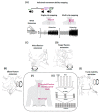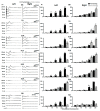Multi-Site Spinal Cord Transcutaneous Stimulation Facilitates Upper Limb Sensory and Motor Recovery in Severe Cervical Spinal Cord Injury: A Case Study
- PMID: 37445450
- PMCID: PMC10342540
- DOI: 10.3390/jcm12134416
Multi-Site Spinal Cord Transcutaneous Stimulation Facilitates Upper Limb Sensory and Motor Recovery in Severe Cervical Spinal Cord Injury: A Case Study
Abstract
Individuals with cervical spinal cord injury (SCI) rank regaining arm and hand function as their top rehabilitation priority post-injury. Cervical spinal cord transcutaneous stimulation (scTS) combined with activity-based recovery training (ABRT) is known to effectively facilitate upper extremity sensorimotor recovery in individuals with residual arm and hand function post SCI. However, scTS effectiveness in facilitating upper extremity recovery in individuals with severe SCI with minimal to no sensory and motor preservation below injury level remains largely unknown. We herein introduced a multimodal neuro-rehabilitative approach involving scTS targeting systematically identified various spinal segments combined with ABRT. We hypothesized that multi-site scTS combined with ABRT will effectively neuromodulate the spinal networks, resulting in improved integration of ascending and descending neural information required for sensory and motor recovery in individuals with severe cervical SCI. To test the hypothesis, a 53-year-old male (C2, AIS A, 8 years post-injury) received 60 ABRT sessions combined with continuous multi-site scTS. Post-training assessments revealed improved activation of previously paralyzed upper extremity muscles and sensory improvements over the dorsal and volar aspects of the hand. Most likely, altered spinal cord excitability and improved muscle activation and sensations resulted in observed sensorimotor recovery. However, despite promising neurophysiological evidence pertaining to motor re-activation, we did not observe visually appreciable functional recovery on obtained upper extremity motor assessments.
Keywords: cervical spinal cord injury; motor rehabilitation; neuromodulation; spinal cord excitability; spinal cord transcutaneous stimulation; upper limb.
Conflict of interest statement
Y.P.G. holds shared interest in Cosyma Inc. and Onward. The other authors declare that the research was conducted in the absence of any commercial or financial relationships that could be construed as a potential conflict of interest.
Figures








Similar articles
-
Spinal Cord Transcutaneous Stimulation in Cervical Spinal Cord Injury: A Review Examining Upper Extremity Neuromotor Control, Recovery Mechanisms, and Future Directions.J Neurotrauma. 2024 Sep;41(17-18):2056-2074. doi: 10.1089/neu.2023.0438. Epub 2024 Jul 12. J Neurotrauma. 2024. PMID: 38874496 Review.
-
Combining Spinal Cord Transcutaneous Stimulation with Activity-based Training to Improve Upper Extremity Function Following Cervical Spinal Cord Injury.Annu Int Conf IEEE Eng Med Biol Soc. 2023 Jul;2023:1-4. doi: 10.1109/EMBC40787.2023.10340976. Annu Int Conf IEEE Eng Med Biol Soc. 2023. PMID: 38082735 Clinical Trial.
-
Cervical Spinal Cord Transcutaneous Stimulation Improves Upper Extremity and Hand Function in People With Complete Tetraplegia: A Case Study.IEEE Trans Neural Syst Rehabil Eng. 2020 Dec;28(12):3167-3174. doi: 10.1109/TNSRE.2020.3048592. Epub 2021 Jan 28. IEEE Trans Neural Syst Rehabil Eng. 2020. PMID: 33382659
-
Safety and Feasibility of Cervical and Thoracic Transcutaneous Spinal Cord Stimulation to Improve Hand Motor Function in Children With Chronic Spinal Cord Injury.Neuromodulation. 2024 Jun;27(4):661-671. doi: 10.1016/j.neurom.2023.04.475. Epub 2023 Jun 1. Neuromodulation. 2024. PMID: 37269282
-
Transcutaneous Spinal Stimulation From Adults to Children: A Review.Top Spinal Cord Inj Rehabil. 2023 Winter;29(1):16-32. doi: 10.46292/sci21-00084. Epub 2022 Dec 9. Top Spinal Cord Inj Rehabil. 2023. PMID: 36819932 Free PMC article. Review.
Cited by
-
Non-invasive spinal cord electrical stimulation for arm and hand function in chronic tetraplegia: a safety and efficacy trial.Nat Med. 2024 May;30(5):1276-1283. doi: 10.1038/s41591-024-02940-9. Epub 2024 May 20. Nat Med. 2024. PMID: 38769431 Free PMC article. Clinical Trial.
-
Characterizing neurological status in individuals with tetraplegia using transcutaneous spinal stimulation.Sci Rep. 2023 Dec 6;13(1):21522. doi: 10.1038/s41598-023-48811-0. Sci Rep. 2023. PMID: 38057398 Free PMC article.
-
Repeated epidural stimulation modulates cervical spinal cord excitability in healthy adult rats.Exp Brain Res. 2024 Dec 12;243(1):22. doi: 10.1007/s00221-024-06965-x. Exp Brain Res. 2024. PMID: 39665849
-
Spinal Cord Transcutaneous Stimulation in Cervical Spinal Cord Injury: A Review Examining Upper Extremity Neuromotor Control, Recovery Mechanisms, and Future Directions.J Neurotrauma. 2024 Sep;41(17-18):2056-2074. doi: 10.1089/neu.2023.0438. Epub 2024 Jul 12. J Neurotrauma. 2024. PMID: 38874496 Review.
-
Transcutaneous spinal stimulation provides characterization of neurological status in individuals with tetraplegia.Res Sq [Preprint]. 2023 Nov 8:rs.3.rs-3513515. doi: 10.21203/rs.3.rs-3513515/v1. Res Sq. 2023. Update in: Sci Rep. 2023 Dec 6;13(1):21522. doi: 10.1038/s41598-023-48811-0. PMID: 37986790 Free PMC article. Updated. Preprint.
References
-
- Birmingham U. National Spinal Cord Injury Statistical Center, Facts and Figures at a Glance. University of Alabama; Birmingham, AL, USA: 2021.
-
- Lo C., Tran Y., Anderson K., Craig A., Middleton J., Sabre L., Harro J., Eensoo D., Vaht M., Kabel V., et al. Functional Priorities in Persons with Spinal Cord Injury: Using Discrete Choice Experiments To Determine Preferences. J. Neurotrauma. 2016;33:1958–1968. doi: 10.1089/neu.2016.4423. - DOI - PubMed
-
- Peckham P., Keith M.W., Kilgore K., Grill J.H., Wuolle K.S., Thrope G.B., Gorman P., Hobby J., Mulcahey M., Carroll S., et al. Efficacy of an implanted neuroprosthesis for restoring hand grasp in tetraplegia: A multicenter study. Arch. Phys. Med. Rehabil. 2001;82:1380–1388. doi: 10.1053/apmr.2001.25910. - DOI - PubMed
-
- Lu D.C., Edgerton V.R., Modaber M., AuYong N., Morikawa E., Zdunowski S., Sarino M.E., Sarrafzadeh M., Nuwer M.R., Roy R.R., et al. Engaging Cervical Spinal Cord Networks to Reenable Volitional Control of Hand Function in Tetraplegic Patients. Neurorehabilit. Neural Repair. 2016;30:951–962. doi: 10.1177/1545968316644344. - DOI - PMC - PubMed
Grants and funding
LinkOut - more resources
Full Text Sources
Medical
Miscellaneous

